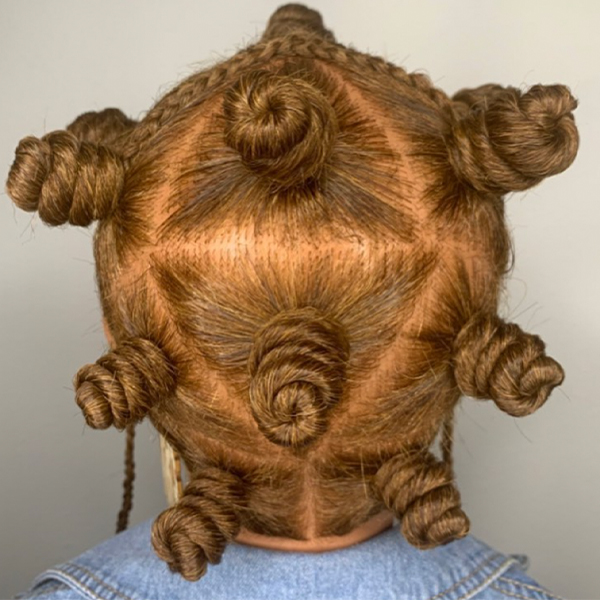3 Must-Know Facts About Low Tension Protective Styles
Here’s How Low Tension Elevates Protective Styling
While protective styles are meant to protect curly, coily and textured hair, they can do just the opposite if they’re styled too tightly. That’s why JCPenney Salon Senior Manager of Education & Service Jaimee Harris Smith (@hairbyjsmith) uses low tension protective styles to keep her clients’ hair healthy and looking its very best.
Keep scrolling to learn how low tension adds comfort, longevity and confidence to protective styles.
Watch the video above to see Jaimee’s technique for creating LOW TENSION Bantu knots!
1. Protective styles with too much tension can cause damage.
Protective styles are designed to protect fragile ends, reduce breakage, promote length retention and help keep the hair healthy. But when these styles put too much tension on the hair and scalp, their benefits can’t be attained.
“Too much tension on any area of the head can affect the wearability of the style and health of the hair and scalp…If your style causes discomfort to the client’s scalp or breakage to their hair, is not protective,” Jaimee explains. “Damage often starts during the installation and styling process. Symptoms such as redness, bumps, soreness and pain are signs that your style has too much tension.”
Pro tip: Jaimee also makes a point to educate her clientele about caring for their style after they leave the salon—like moisturizing their hair and scalp on a daily basis, or wearing a silk or satin scarf while they sleep.
Check out these lovely flat twists by Jaimee:

The more you learn, the more you earn. Unlock 150+ classes and step-by-step tutorials with BTC University. Join here!
2. Low tension is essential for avoiding breakage & discomfort.
To make protective styles truly protective, adjusting the tension to be a comfortable fit for the client and their hair is an absolute must.
“When creating Bantu knots [and other protective styles], the tension can be adjusted,” Jaimee explains. “Being mindful of the pressure used when twisting and manipulating the section will avoid putting too much tension on the hairline, nape and hair strands…Some popular low tension protective styles are a two-strand twist, knotless braids, ponytails, heatless sets and more!”
Pro tip: Want to make your client’s fresh protective style last as long as possible? Use nourishing, moisturizing products to keep their scalp healthy, partings clean and hair properly secured. Watch Jaimee’s Bantu knot technique for her recommended oil, moisturizer, edge tamer and more.
Jaimee’s gorgeous Bantu knots:

Up to 70 percent commission, flexible hours, PTO, ZERO rental booth fees and more—join JCPenney Salon’s professional team!
3. Low tension protective styles are ideal for hair in need of rest.
If your client is looking for a style that will tuck their hair away and give it a rest from daily treatments, heat and manipulation, a low tension protective style is a great option.
Here’s how Jaimee breaks down her protective styling appointments:
- Start with a strong consultation about the client’s hair goals, including a hair and scalp analysis. This will help you understand what the client is looking for and what styles their hair can support.
- Cleanse, condition and prep the hair. Jaimee recommends using specialized products—such as the Almond & Avocado line from Design Essentials—that help detangle, moisturize and prepare the hair for sleek, polished results.
- Start styling, being mindful of your technique and avoiding over-twisting or over-manipulating the hair. Use your professional eye and judgment, and remember to check in with your clients throughout the appointment to make sure they don’t feel any discomfort.
- Click here to watch the rest of Jaimee’s tips in action!
Pro tip: According to Jaimee, adding hair extensions to some of your protective styles can help them last longer. However, it’s essential to be cautious about using extensions that are heavy or put stress on the hair and scalp.
Watch Jaimee spice up her protective braids with some Bantu knots:
View this post on Instagram
Ready to take the next step in your career? Join JCPenney Salon and gain access to mentoring opportunities, paid artistic training, 401k retirement and more!
More from
JCPenney Salon
-
Curls
Protective Styling: How To Create Perfect Bantu Knots
-
Business
How the Right Salon Can Help You Build A Successful Career
-
Blowouts
3 Fast Blowout Tips For Bobs & Lobs
-
Curls
Flexi-Rod Set: 4 Tips For Bouncy, Long-lasting Curls
-
Braids
Braiding Tips To Upgrade Upstyles
-
Facebook Lives
Bantu Knots, Foil Rods & Comb Twist Sets: 3 Setting Techniques For Natural Hair
-
Award-Winning
NAHA 2020: Styling & Finishing Award
-
Award-Winning
NAHA 2020: Team of the Year
-
Manufacturer
JCPenney Announces New Additions To The Salon By InStyle
-
#thebtcshow 2019
#THEBTCSHOW 2019: DAY 3
-
#thebtcshow 2019
Texture Co-Lab at #THEBTCSHOW 2019
-
BTC Events
BTC “ON TOUR” DALLAS
-
BTC ON TOUR
“On Tour” Dallas Cocktail Party
-
BTC Events
BTC “On Tour” Dallas Show—Here’s Everything That Happened!
-
New Appointments
JCPenney Names Rachel Jud As Vice President Of Salon
-
BTC Events
Everything That Went Down At BTC “ON TOUR” Chicago
-
BTC Events
BTC “ON TOUR” CHICAGO
-
Conditioners
Textured Hair Troubles? Read This!
-
BTC Events
BTC’s “On Tour” Show Is Coming To Chicago—Here’s The Artist Lineup!
-
Braids
No-Heat Styles To Teach Your Clients
-
Business
Four Ways To Support Breast Cancer Awareness Month From JCPenney Salons
-
Braids
WATCH: Braids, Knots + Upstyling Cheats
-
Blowouts
Don’t Let Your Client Leave Without This Blowout
-
Haircuts
Long-Layered Cut






